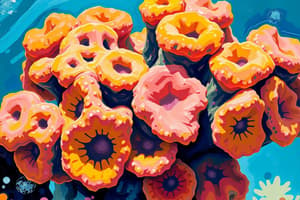Podcast
Questions and Answers
What does Calasea primarily consist of?
What does Calasea primarily consist of?
- Spicules of calcium carbonate (correct)
- Spicules of silica
- Brightly colored sponges
- Simple body form with astia holes
What are the defining features of Hexactinellida?
What are the defining features of Hexactinellida?
Spicules have 6 rays, spicules of silica, arranged as lattuce.
What type of spicules do Demospongiae have?
What type of spicules do Demospongiae have?
Spicules of silica or spongin.
Dascon is the simplest body form of sponge, characterized by the presence of ______ holes.
Dascon is the simplest body form of sponge, characterized by the presence of ______ holes.
What is the function of choanocytes in the Sycon class?
What is the function of choanocytes in the Sycon class?
What characterizes the Leucon body form?
What characterizes the Leucon body form?
Flashcards
What makes up Calasea?
What makes up Calasea?
Calcareous spicules, composed of calcium carbonate, are the primary structural components.
What are the distinct features of Hexactinellida?
What are the distinct features of Hexactinellida?
Hexactinellida sponges are uniquely defined by their spicules, which have six rays and are made of silica, resembling a lattice structure.
What kind of spicules does Demospongiae have?
What kind of spicules does Demospongiae have?
Demospongiae sponges possess spicules made of either silica or spongin, a protein-based material, providing structural support and flexibility.
What is a Dascon?
What is a Dascon?
Signup and view all the flashcards
What is the role of choanocytes in Sycon class?
What is the role of choanocytes in Sycon class?
Signup and view all the flashcards
What is the Leucon body form?
What is the Leucon body form?
Signup and view all the flashcards
Study Notes
Classes of Phylum Porifera
-
Calasea: Characterized by spicules made of calcium carbonate; exhibits asymmetrical or radial symmetry; spicules typically have 3 or 4 rays; can exhibit ascon, leucon, or sycon body forms.
-
Hexactinellida: Known as "glass sponges", these spicules contain silica and have six rays; often found in deep sea environments; includes notable species like the Venus flower basket; arrange rays in a lattice structure; can form sycon or leucon body types.
-
Demospongiae: Comprises brightly colored sponges with spicules made of silica or spongin; mostly represented in leucon body form; includes familiar species like bath sponges and freshwater spongilla.
Body Forms of Sponges
-
Dascon: Represents the simplest and least common sponge body type; features astia holes for water entry; has a central cavity known as spongacoeli; water exits through osculum; lined with choanocytes on the inner surface of the spongacoeli.
-
Sycon: Includes radial canals that are covered by an additional wall, enhancing surface area for filtration; contains more choanocytes for efficient water processing; maintains dermal pores analogous to astia; water flows into the spongacil and exits via the osculum.
-
Leucon: Exhibits extensive branching, resulting in an increased number of choanocytes; water is drawn into chambers for filtration; water exits through osula; this form represents the majority of existing sponge species today.
Studying That Suits You
Use AI to generate personalized quizzes and flashcards to suit your learning preferences.




